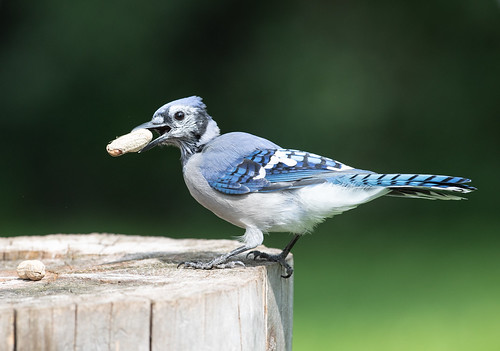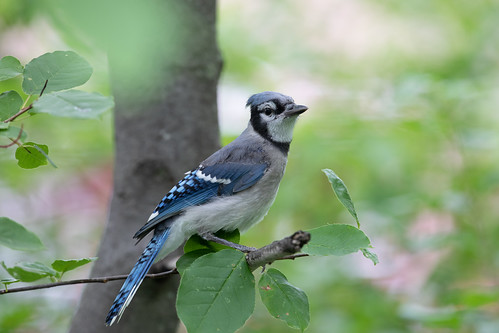I’ve read of people who claim to tell their individual Blue Jays apart by facial markings, but to my eyes, Blue Jays all look pretty much the same. I do learn to recognize a few individuals, but only because some develop unique behaviors.
During July and August, until the adults finish their molts, even if I can’t tell them individually apart, it’s easy to distinguish fledglings from parents. At first the young birds have very short tails, but even as those tail feathers grow longer and longer, the young still have sort of a baby look, and every one of their feathers is brand new.
The adults start out the summer looking perfectly splendid, but their feathers are each a year old, and as they start molting, they get a scraggly look.
The tail feathers don’t all grow in simultaneously—they drop them one or two at a time, and if you get a good look, you can see that they’re different lengths.
But the adults always look pretty good until they start molting their head feathers. The ones that lose a few feathers at a time may look ridiculous for a few weeks, but nowhere near as absurd as those that molt all their head feathers simultaneously.
This year, my neighborhood Blue Jay population includes two different families that visit my backyard. I managed to get photos of fledglings of the first family begging for food on July 11; their tails were almost full length already, which meant their parents had been successful nesting early this year.
The young were still associating with the parents, but not begging so much, on August 7, when I got photos of one of those parents molting all its head feathers—the very first bald Blue Jay photos I ever took.
That same day, August 7, I got photos of the other family—the fledglings’ tails were shorter than the tails of the first family’s young at the time I’d first photographed them in July.
These parents had grown very tolerant of me when I whistled, flying in and alighting in our apple tree to see where I’d put the peanuts. I usually set them on a stump under the tree and sat down nearby. The sparse foliage of the apple tree allowed me to get lots of photos of begging fledglings and parents feeding them, as well as pictures of the parents alighting on the stump. And one of those parents was completely bald, giving me my best bald Blue Jay photos on August 13.
Despite the myths that baldness in Blue Jays is caused by mites or other physical problems, all those dropped head feathers are very quickly replaced. My first Blue Jay family didn’t spend as much consistent time in my yard as the second one did, so I didn’t see how quickly that bald parent’s feathers grew back in, but this week, on August 25, I got a new photo of that bald jay I’d photographed just 12 days before.
The feathers aren’t all the way grown in, but the bird looks far, far more normal now, and should be in perfect plumage in a few more days. I suspect when people claim they’ve seen bald jays for several weeks, they’ve usually actually been seeing more than one individual—the one advantage to molting the head feathers simultaneously is that the molt lasts for a shorter length of time than when it’s more spread out.
So add baldness to the list of ways birds are superior to humans. Human hair doesn’t serve a critical function since we can always can protect our heads from too much sun and too much cold by simply donning a hat, yet Americans spend a billion dollars a year trying to reverse baldness. Some birds, such as vultures and storks, spend their whole lives bald, but don’t seem the least bit concerned about it. The few Blue Jays and cardinals who molt all their head feathers simultaneously may be mildly embarrassed by the situation, but it lasts just a short time, and birds aren't into mirrors, anyway. Maybe it was to get revenge that people used to kill wild birds for their feathers.











